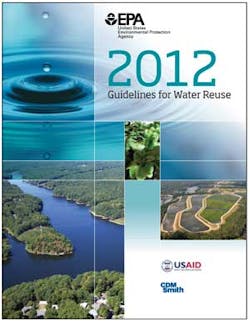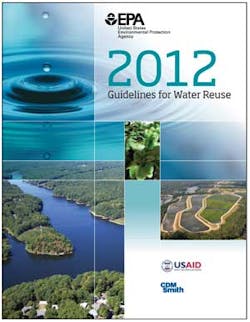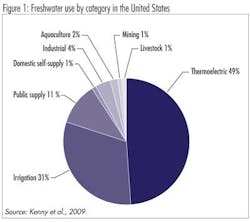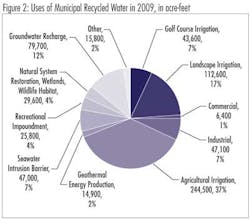Updated Guidelines Reflect Growing Interest in Water Reuse
By James Laughlin, WaterWorld Editor
The new 2012 edition of the Environmental Protection Agency's Guidelines for Water Reuse reflect the growing interest in water reuse in the United States and around the world. The guidelines, released earlier this month, include a host of case study examples to illustrate that trend.
Last updated in 2004, the guidelines summarize U.S. and international regulations and water reuse practices. The document provides information on planning for future water reuse systems, as well as indirect potable reuse and industrial reuse. Disinfection and treatment technologies, emerging contaminants, and public involvement and acceptance are also covered.
The 2012 update includes significant changes that reflect the evolving interest in water reclamation and reuse, said Bob Matthews, CDM Smith Senior Vice President. Matthews contributed to the first edition of the Water Reuse Guidelines, published in 1980, as a young staff engineer working on an agricultural reuse project in Florida. He was actively involved in the 1992 and 2004 updates and served as project manager for CDM Smith on the current update.
"When you go back to the 1980s, an awful lot of reuse was effluent disposal driven. Now, it's really part of integrated water use planning and management," Matthews said. "We're seeing far greater interest and use even in states that are outside the Sunbelt."
More than 60 people served as contributing authors for the updated report, with a broad spectrum of expertise in planning, researching, designing, building and operating reuse programs in the U.S. and around the world.
There have been big changes in the past eight years since the last update, Matthews said.
"One of the chapters we added this time this has to do with the growing interest and development in the United States," he said. "We have a chapter that looks at regional considerations in the United States for usage, increased volumes and other regional considerations.
"I think that's important because it supports how much reuse has been growing in the United States. If you went back to 1992 and did a regional perspective, you would probably have the Southwest and the Southeast. Now you see quite a bit of reuse in other portions of the country."
The section focused on international acceptance of water reuse also has grown. The guidelines highlight reuse projects around the world, helping illustrate how reuse has developed in various countries over time.
"We have a fuller range of reuse applications throughout the world," Matthews said. "You've got some basic types of reuse with low levels of treatment all the way up to very sophisticated programs."
The guidelines focus on the importance of integrated water resources and the vital role played by water reuse programs. The updated guidelines add a variety of case studies providing real real-world examples of programs in the U.S. and abroad.
While the 2012 edition includes an overview of treatment technologies, that is not its primary focus.
"Since 2004 there have been a number of other documents that have been published that go into great detail on treatment technologies, so EPA felt we didn't need to repeat that," Matthews said. Those studies are referenced in the guidelines.
One new section presents updated studies and research that focuses on contaminants of emerging concern, including pharmaceutical products, endocrine disruptors and personal care products, and the role they might play in water reuse programs.
An entire chapter is devoted to public acceptance of water reuse. The new guide will include a selection of case studies demonstrating the increasing acceptance of reuse. Some cities have successfully touted the "green" benefits of water resulting in communities embracing and supporting reclaimed water use for irrigation.
"There is a growing interest in industrial reuse," Matthews said. "There have been a number of very successful power plant projects where they have increased the use of reclaimed water for cooling plant purposes."
In recent years the use of aquifers for water storage has grown, helping deal with seasonal fluctuations in supply and demand. Matthews pointed to Florida, which gets most of its rain in the three months of summer but sees its population swell in the winter as tourists flock to the state.
"There are periods when you have more reclaimed water than you need, and periods when you don't have quite enough," he said. "You can temporarily store reclaimed water for a period of time in an aquifer then bring it back up, treat it, and have it available for customers."
The guidelines provides several case study examples of groundwater augmentation and aquifer storage.
Individual onsite reuse of greywater is also a new addition to the guide. The discussion includes considerations for treatment and monitoring requirements, with examples of small scale programs being developed.
The 2012 Guidelines for Water Reuse will not be available in print format. EPA is providing the document in a PDF format for free download from the agency's website, www.waterreuseguidelines.org. The document makes extensive use of hyperlinks, referring readers to other documents and studies available on the Internet.
"It truly is an outstanding guidance document," Matthews said. "I'm a little subjective about my comments on this, but I have seen a number of states, such as Georgia and Virginia, who used it extensively as a reference document to help support different aspects of their programs."



